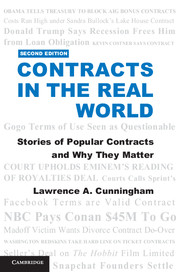Book contents
- Frontmatter
- Dedication
- Contents
- Annotated Contents
- Acknowledgments
- Introduction
- 1 Getting In: Contract Formation
- 2 Facing Limits: Unenforceable Bargains
- 3 Getting Out: Excuses and Termination
- 4 Paying Up: Remedies
- 5 Rewinding: Restitution and Unjust Enrichment
- 6 Writing It Down: Interpretation, Parol, Frauds
- 7 Performing: Duties, Modifi cation, Good Faith
- 8 Hedging: Conditions
- 9 Considering Others: Third Parties and Society
- Conclusion
- Appendix A Offering and Accepting
- Appendix B Buying and Selling Goods
- Notes
- Table of Cases
- Index
8 - Hedging: Conditions
Published online by Cambridge University Press: 05 March 2016
- Frontmatter
- Dedication
- Contents
- Annotated Contents
- Acknowledgments
- Introduction
- 1 Getting In: Contract Formation
- 2 Facing Limits: Unenforceable Bargains
- 3 Getting Out: Excuses and Termination
- 4 Paying Up: Remedies
- 5 Rewinding: Restitution and Unjust Enrichment
- 6 Writing It Down: Interpretation, Parol, Frauds
- 7 Performing: Duties, Modifi cation, Good Faith
- 8 Hedging: Conditions
- 9 Considering Others: Third Parties and Society
- Conclusion
- Appendix A Offering and Accepting
- Appendix B Buying and Selling Goods
- Notes
- Table of Cases
- Index
Summary
The courts should not be the places where resolution of disputes begins. They should be the places where the disputes end after alternative methods of resolving disputes have been considered and tried.
– Sandra Day O'ConnorInterpretation and Effect: Kevin Costner's Bison
Kevin Costner cemented his leadership in the Hollywood scene by his production of the heroic 1990 film “Dances With Wolves,” in which he starred as Lt. John J. Dunbar. The film, shot in the Black Mountains near Deadwood, South Dakota, inspired Costner's fantasy of developing a luxury resort hotel in the area, where he bought 1,000 acres of land. Despite spending two decades and several of the millions he earned from the film on this dream resort, to be named the Dunbar, it never panned out. For the centerpiece of his plans, Costner commissioned seventeen massive bronze sculptures, assembled as the “Lakota Bison Jump,” from the noted local artist Peggy Detmers. The sculptures depict three Native Americans hunting fourteen bison on horseback, at 125 percent of life scale. Costner initially commissioned the sculptures in 1994 under an oral agreement, paying Detmers $250,000. The two agreed to share royalties from sales of reproductions of the sculptures, which they expected would sell for up to $250,000 apiece.
By 2000, however, the resort was not yet underway, and Detmers became anxious about whether her sculptures would be displayed and royalties on sales begin to flow. Costner reassured her in a two-page letter of May 2000. After noting that Costner was paying Detmers another $60,000, this letter outlined how the two would promote fine art reproductions of the sculptures and share royalties on sales. The letter gave Costner sole discretion over displaying the sculptures during the period before the Dunbar was built. Notably, the letter provided what would happen if the Dunbar were not built within a decade: “Although I do not anticipate this will ever arise, if the Dunbar is not built [by 2010] or the sculptures are not agreeably displayed elsewhere, I will give you 50% of the profits from the sale” of the sculptures.
Detmers completed the sculptures in 2002, but the resort was still not under construction. Costner elected to place the sculptures on his 1,000-acre property – intended as the site for construction of the Dunbar.
- Type
- Chapter
- Information
- Contracts in the Real WorldStories of Popular Contracts and Why They Matter, pp. 199 - 220Publisher: Cambridge University PressPrint publication year: 2016



